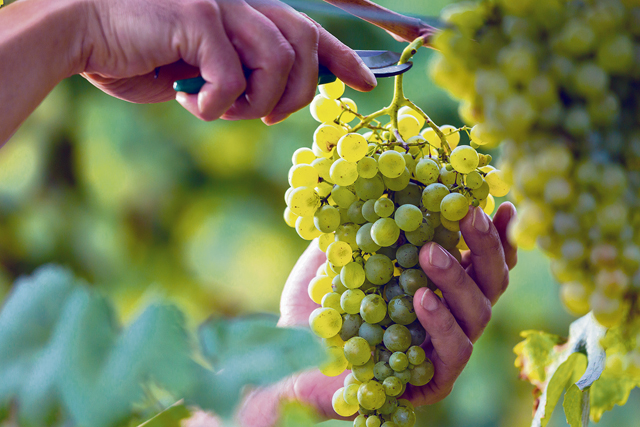
If you’re a lover or even connoisseur of great wines, or rather prefer fruity grape juice, you’re just in the right place to be. Germany is one of Europe’s largest winegrowing countries and the state of Rheinland-Pfalz produces two-thirds of the country’s fine wines.
The Moselle and Saar valleys along with Rheinhessen are well-known grape growing regions. Most of the vineyards are on or very close to the 50th latitude, which is rather unusual in international comparison. High quality and successful viticulture is only possible based on a special unique meso and microclimate condition.
The “Deutsche Weinstrasse” (German wine road) stretches 85 kilometers from Rheinhessen in the north to the French Alsace region in the southwest and ends at Deutsches Weintor (wine gate). Many famous towns such as Bad Dürkheim, Neustadt and Landau lie along the way and the region is renowned for vineyards as far as the eye can see on flat plains in close proximity to the Rhine River. The special mild climate zone provides 1.800 hours of sun a year.
Another famous viticulture region is along the Moselle and Saar rivers, but on steep slopes with up to 60 percent inclines. Approximately 60 million vines grow along the steep hills where the winding rivers reflect sunlight onto the slopes and warm the vines to ripen to a plentiful harvest.
The Celts were the first to cultivate white grapes along the banks and slopes of the Moselle river almost 3000 years ago. The Romans refined the winemaking process, improved the quality and eventually introduced darker red grapes. As wine consumption of the Romans grew along with the empire throughout the centuries, soldiers and civil servants were paid with wine, rather than coins, and even slaves received a daily ration.
About 9.25 million hectoliters (2.4 million gallons) of wine are produced annually in Germany and approximately 257,000 hectoliters (6,789,221 gallons) alone are exported to the United States.
September marks the beginning of the harvest season which can last until December. Large state-of-the art grape harvesters can pick the grapes on even surfaces. The machines are able to pull the actual grape fruits off the small twigs and leaves by shaking and rattling them before they are conveyed to a large container. However, the vineyards on the steep slopes of the Moselle and Rhine Rivers have to be picked by hand, a very tedious and back-aching task, with thousands of harvesters working with century old techniques.
After the initial grape pressing process, also known as keltering, the premier wine produced is called “Federweisser” (feather white) because of its milky, white color. Although very sweet in taste, it also has a high alcohol content and is often sold in containers in little booths along the roadside.
A tradition that comes with the season is delicious and spicy “Zwiebelkuchen” (onion cake) together with the semi-processed wine. The warm dish, more of a quiche than a typical cake, with onions and bacon bits, is a perfect complement to the fizzy new wine. Freshly pressed, pure and sweet grape juice is also a perfect alternative for those that prefer a non-alcoholic delight.
After the first winter frost in late November or early December, the very last grapes are handpicked and processed into a sweet, rare and expensive “Eiswein” (ice wine).
Wine festivals take place in almost every village throughout the season and Neustadt/Weinstrasse is the host of the German Weinlese Fest (wine harvest fest) with a parade and a wine village set up with wooden booths to celebrate the harvest season. The German Weinkönigin (wine queen), required to have a broad knowledge about the different types of grapes and wines and their making, is crowned for a year. This year the festival will take place Sep. 22 to Oct. 9 with a parade on Sunday, Oct. 8.
Bad Dürkheim hosts the world’s largest wine fest called “Wurstmarkt,” which will take place Sep. 8-12 and 15-18. The “Fest des Federweissen” is scheduled in Landau Oct. 12-15. Don’t miss out on these special occasions in Germany’s largest wine producing state.


